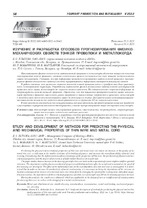| dc.contributor.author | Ельцова, Е. С. | ru |
| dc.contributor.author | Бобарикин, Ю. Л. | ru |
| dc.contributor.author | Мартьянов, Ю. В. | ru |
| dc.coverage.spatial | Минск | ru |
| dc.date.accessioned | 2023-01-20T11:32:57Z | |
| dc.date.available | 2023-01-20T11:32:57Z | |
| dc.date.issued | 2022 | |
| dc.identifier.citation | Ельцова, Е. С. Изучение и разработка способов прогнозирования физико-механических свойств тонкой проволоки и металлокорда = Study and development of methods for predicting the physical and mechanical properties of thin wire and metal cord / Е. С. Ельцова, Ю. Л. Бобарикин, Ю. В. Мартьянов // Литье и металлургия. – 2022. – № 4. – С. 58-62. | ru |
| dc.identifier.uri | https://rep.bntu.by/handle/data/125250 | |
| dc.description.abstract | Прогнозирование физико-механических свойств тонкой проволоки и металлокорда обеспечит повышение качества латунированной тонкой проволоки, снижение количества и времени технологических пауз, повысит технологичность свивки металлокорда. Учитывая, что при деформации проявляется анизотропия свойств тонкой проволоки, прогнозирование физико-механических свойств и степени неравномерности деформации становится актуальной задачей. В работе показано, что увеличение скорости волочения тонкой проволоки ведет к приобретению более равномерной и мелкозернистой структуры. Разработаны зависимости физико-механических свойств тонкой латунированной проволоки после свивки металлокорда от скорости тонкого волочения. Исследовано влияние скорости деформации на микротвердость тонкой стальной проволоки. Определено, что для повышения производительности свивки металлокорда требуется привести зависимость роста твердости и эквивалентных напряжений в проволоках металлокорда к линейному виду путем изменения скорости свивки на отдельных ее этапах. Для практического использования выведены зависимости механических свойств тонкой проволоки класса прочности HT от скорости волочения. В ходе проведения анализа были получены результаты, которые применимы при проектировании новых или доработки существующих маршрутов волочения тонкой проволоки, а также при проектировании новых конструкций металлокорда. | ru |
| dc.language.iso | ru | ru |
| dc.publisher | БНТУ | ru |
| dc.title | Изучение и разработка способов прогнозирования физико-механических свойств тонкой проволоки и металлокорда | ru |
| dc.title.alternative | Study and development of methods for predicting the physical and mechanical properties of thin wire and metal cord | ru |
| dc.type | Article | ru |
| dc.identifier.doi | 10.21122/1683-6065-2022-4-58-62 | |
| local.description.annotation | Predicting the physical and mechanical properties of thin wire and metal cord will ensure an increase in the quality of latuned thin wire, a reduction in the number and time of technological pauses, and increase the manufacturability of metal cord twisting. Considering that the deformation manifests anisotropy of the properties of thin wire, the prediction of physical and mechanical properties and the degree of unevenness of deformation becomes an urgent task. The paper studies that an increase in the drawing speed of a thin wire leads to the acquisition of a more uniform and fine-grained structure. The dependences of the physico-mechanical properties of thin latuned wire after the metal cord is twisted on the speed of fine drawing are developed. The effect of the deformation rate on the microhardness of a thin steel wire is investigated. It is determined that in order to increase the productivity of metal cord twisting, it is necessary to bring the dependence of the increase in hardness and equivalent stresses in metal cord wires to a linear form by changing the speed of the twisting at its individual stages. For practical use, the dependences of the mechanical properties of a thin wire of strength class HT on the drawing speed are derived. During the analysis, the results were obtained, which are applicable in the design of new or modification of existing routes for drawing thin wire, as well as in the design of new metal cord structures. | ru |

